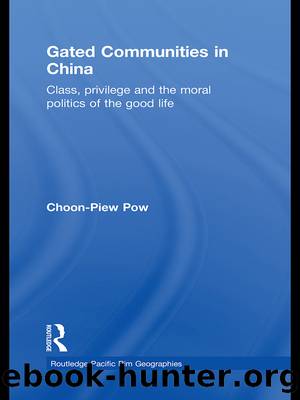Gated Communities in China by Pow Choon-Piew;Pow Choon-Piew;

Author:Pow, Choon-Piew;Pow, Choon-Piew;
Language: eng
Format: epub
Tags: Development Studies
Publisher: Taylor & Francis Group
Furthermore, according to Zhang (2001), when peasant workers began appearing in cities in the early 1980s, they were generally seen by the urban public initially as temporarily displaced outsiders (waidiren) who would soon return to their rural origins. As more and more peasants poured into towns and cities, putting stress on urban infrastructure and resources, they came to be regarded as a social problem despite their enormous economic contributions. Spatially and socially detached from their home villages, rural migrants could no longer be directly reached by the rural authority in their places of origin; but at the same time they were considered outsiders by city officials. Hence, without a clear structural position in the reform Chinese society, migrants appeared detached from the existing social system and became a people of âprolonged liminalityââbelonging neither to the rural nor to the urban society (Zhang, 2001:27). This liminal status in turn reinforces another set of disparaging discourses that cast rural migrant workers as outsiders and strangers who are out of place in the city. To compound the issue further, Fan (2002), in her study on Guangzhouâs labour market segmentation, points out that temporary migrant workers often find themselves situated at the bottom of the occupation hierarchy in the city as a result of the unequal âinstitution-based opportunity structureâ that could be traced to the migrantsâ lack of urban residential status (hukou). As a result of their disadvantaged institutional positions, temporary migrant workers are often channelled to low-paying and undesirable jobs, thereby further reinforcing their marginal status as inferior outsiders (see also Roberts, 1997, 2002).
According to Yi-fu Tuan (1986), outsiders by implication belong to a lower order in many societies. They are strangers who have not submitted to local culture at its best. They are raw, unpredictable and dangerous. The existence of outsiders is a result of the prior existence of a classificatory system that inscribes familiarity and order in an otherwise chaotic world. The migrant worker in Shanghai is a case in point. In particular, migrant workers are often seen as outsiders who threaten the morality and social order of the city. This fear and suspicion of outsiders is an enduring theme that resonates in many historical studies on urban Chinese societies. For example, William Roweâs (1989) study on the port city of Hankow during the nineteenth century reveals how labourers, refugees, vagabonds and beggars were often denigrated as ârootless peopleâ who summoned up a âpathology of fearâ and distaste in the public consciousness of the port cityâs permanent residents. According to Rowe, the local hostility these rootless people attracted resulted in part from their unsettled status, which made them appear prone to criminal and deviant behaviour; basically they were outsiders who, by staying, had violated the rules of the game. In Hankow, more established citizens by no means welcomed the growing number of mobile and ârootlessâ people, also termed wu-lai (literally âhaving no place to turnâ). As Rowe (1989:217) notes:
Owing allegiance to no man, without a guarantor or frequently even familial responsibilities to impel them to social respectability; wu-lai were flesh and blood hungry ghosts.
Download
This site does not store any files on its server. We only index and link to content provided by other sites. Please contact the content providers to delete copyright contents if any and email us, we'll remove relevant links or contents immediately.
Spell It Out by David Crystal(36016)
Life for Me Ain't Been No Crystal Stair by Susan Sheehan(35713)
Cecilia; Or, Memoirs of an Heiress — Volume 1 by Fanny Burney(32396)
Cecilia; Or, Memoirs of an Heiress — Volume 3 by Fanny Burney(31786)
Cecilia; Or, Memoirs of an Heiress — Volume 2 by Fanny Burney(31757)
The Great Music City by Andrea Baker(31230)
Professional Troublemaker by Luvvie Ajayi Jones(29564)
We're Going to Need More Wine by Gabrielle Union(18929)
The Secret History by Donna Tartt(18792)
Twilight of the Idols With the Antichrist and Ecce Homo by Friedrich Nietzsche(18472)
All the Missing Girls by Megan Miranda(15452)
Cat's cradle by Kurt Vonnegut(15128)
Pimp by Iceberg Slim(14273)
Bombshells: Glamour Girls of a Lifetime by Sullivan Steve(13942)
Talking to Strangers by Malcolm Gladwell(13162)
Norse Mythology by Gaiman Neil(13157)
Fifty Shades Freed by E L James(13140)
For the Love of Europe by Rick Steves(12480)
The Social Justice Warrior Handbook by Lisa De Pasquale(12103)
